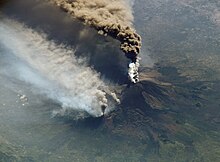Mount Etna

Mount Etna is a volcano on the east coast of Sicily, part of southern Italy. It is the largest active volcano in Europe. Mount Etna erupts every few years.
Etna's most destructive eruption in historic times started on 11 March 1669. It produced lava flows that destroyed 10 villages and reached the town of Catania five weeks later, on 15 April. Many buildings were destroyed and few people were killed.

Major twentieth century eruptions occurred in 1928, 1949, 1971, 1983 and 1992, as well as the 2001 eruption. In 1971, it buried the Etna Observatory (built in the late 19th century) under lava. The 1992 eruption saw the town of Zafferana threatened by a lava flow, but successful diversion efforts saved the town with the loss of only one building a few hundred metres outside it.
In 2002–2003, the biggest series of eruptions for many years threw up a huge column of ash that could easily be seen from space and fell as far away as Libya, on the far side of the Mediterranean Sea. Seismic activity in this eruption caused the eastern flanks of the volcano to slip by up to two metres, and many houses on the flanks of the volcano were damaged. The eruption also destroyed the Rifugio Sapienza, a ski resort on the southern flank of the volcano.
Related pages
[change | change source]References
[change | change source]- Chester, D.K.; et al. (1985). Mount Eta: the anatomy of a volcano. Stanford University Press. ISBN 0-8047-1308-1.
Other websites
[change | change source]- Mount Etna Live Webcam Archived 2008-05-17 at the Wayback Machine
- Italy's Volcanoes: The Cradle of Volcanology, with detailed information of Italy's volcanoes, including Etna Archived 2013-01-21 at the Wayback Machine
- Stromboli Online, with info on Etna, photo galleries and video clips of Etna's past eruptions including those of the 1990s and the 2000s
- Mount Vesuvius -Citizendium






